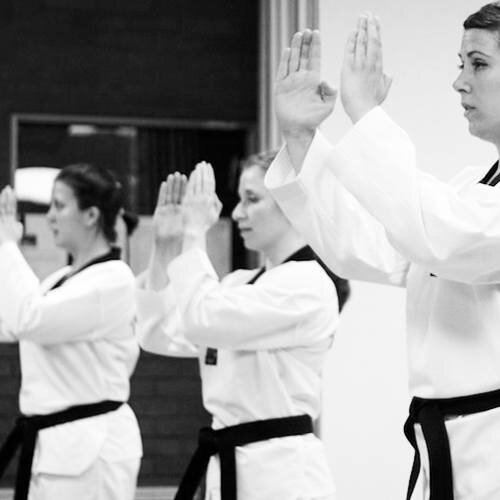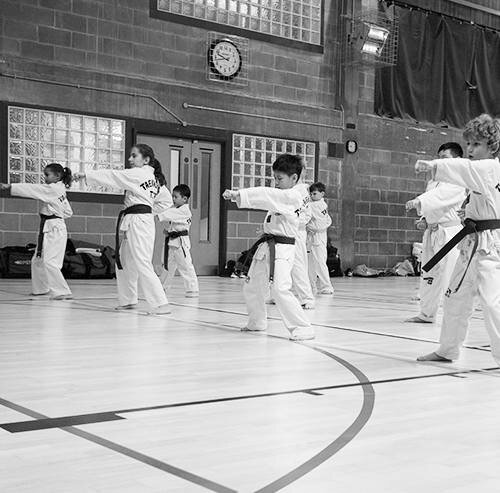What is taekwondo?
Taekwondo is an ancient Korean martial art of self-defence. “Tae” means to kick or smash with the feet, “Kwon” means fist or to punch and “Do” means art or way. Therefore Taekwondo is the art of hand and foot fighting.Taekwondo is an art primarily concerned with self-defence.Taekwondo seeks to train the body with optimum speed and accuracy to effectively defeat any kind of attack.TTA Taekwondo teaches the COMPLETE art of Taekwondo. The philosophy and spirit that is embodied in the ancient art as well as modern up to date sports science practises are combined to provide you with a balanced and complete martial art.
History of Taekwondo
Although it is possible to trace its roots back over a thousand years, the practise of Taekwondo, as a distinct martial art did not exist prior to the mid twentieth century. Taekwondo is a name coined in 1955 to unify a number of native Korean martial arts, the origin of which can also be traced back through Korean history with various evolutionary influences drawn from Japanese and Chinese martial arts.In its early days, Taekwondo was seen by many as nothing more than a Korean interpretation of Japanese Karate. However, during the second half of the twentieth century, the martial art of Taekwondo changed dramatically and established its own distinct identity. This was mostly as a result of Korean attempts to purge foreign influences as well as the application of modern western medical science to improve the efficiency and effectiveness of techniques.In Korea, the practise of Taekwondo spread from the Army into schools and universities, and dojangs (schools) appeared everywhere to spread the art to the general public. Internationally, instructors and demonstration teams travelled the world. By the early 1970s, interested governments had called for instructors to establish schools and teach in their countries, initially in the armed forces and than to the public at large.During the 1980s and 1990s, Taekwondo as a sport grew in popularity, and was accepted as a demonstration sport at the 1988 and 1992 Olympic games, before becoming a permanent sporting event at the Olympics in 2000. It is currently estimated that there are over fifty million Taekwondo practitioners worldwide in over 167 countries.
Tenets of Taekwondo
Courtesy
Integrity
Perseverance
Self Control
Indomitable Spirit
Oath of Taekwondo
I shall observe the Tenets of Taekwondo
I shall respect my Instructor and Seniors
I shall never misuse Taekwondo
I shall be a champion of freedom and justice
I shall build a more peaceful world
Our Philosophy
The ultimate goal of Taekwondo is the attainment of a harmony of physical, mental and spiritual centres to achieve what is often referred to as 'oneness'. This means that a person will do the right thing at the right time without uncertainty, be it avoiding a deadly blow, expressing gratitude or coming to another's aid. Such a person is said to express an intuitive response to life unencumbered by hesitation or self-doubt.The road to this goal is long and arduous and for some may seem impossible. Still, even after a relatively short period of training many will begin to experience a heightened sense of calm and focus. Students will find that they can apply this to other aspects of their life such as work, and parents will notice an improvement in their children's self discipline and integrity. The reason for this is as follows: One of the most stressful things a person can do is fight, so if a person can fight with their mind free of tension, fear or anger, then other events in their life that might otherwise be a source of stress, can be handled objectively and effortlessly. This is achieved as the novice undergoes:
Fitness & co-ordination training
Good co-ordination, toning, reduction of weight, improved flexibility, cardiovascular conditioning, increased strength, general fitness.
Self Discipline
Self confidence, self-discipline, better judgement, self control, stress reduction, better self image, positive attitude.
Team Work
The student learns to work with fellow members as part of the team in class and interrelation between peer groups, seniors and juniors.
Respect
The student takes on more responsibility in terms of looking after juniors and guiding them. At the same time, he or she learns to seek guidance from his or her seniors and is responsible towards them.
High Achievement
The student learns to persevere and develop a strong tenacity to be responsible for his or her actions and achieve set goals and tasks.Students take parts in competitions to test their skills within a controlled environment and to socialise with other like-minded practitioners. They learn to accept defeat and to firm up their resolve to succeed.
High Morality
With the acquiring of skills which convert his or her hands and feet into lethal weapons, the student learns to abide by the tenets and oath of Taekwondo to achieve a sense of fair play, justice and loyalty to the ethics of Taekwondo.Not all Taekwondo schools advocate these methods. These are the ways of the Traditional Taekwondo Association.



